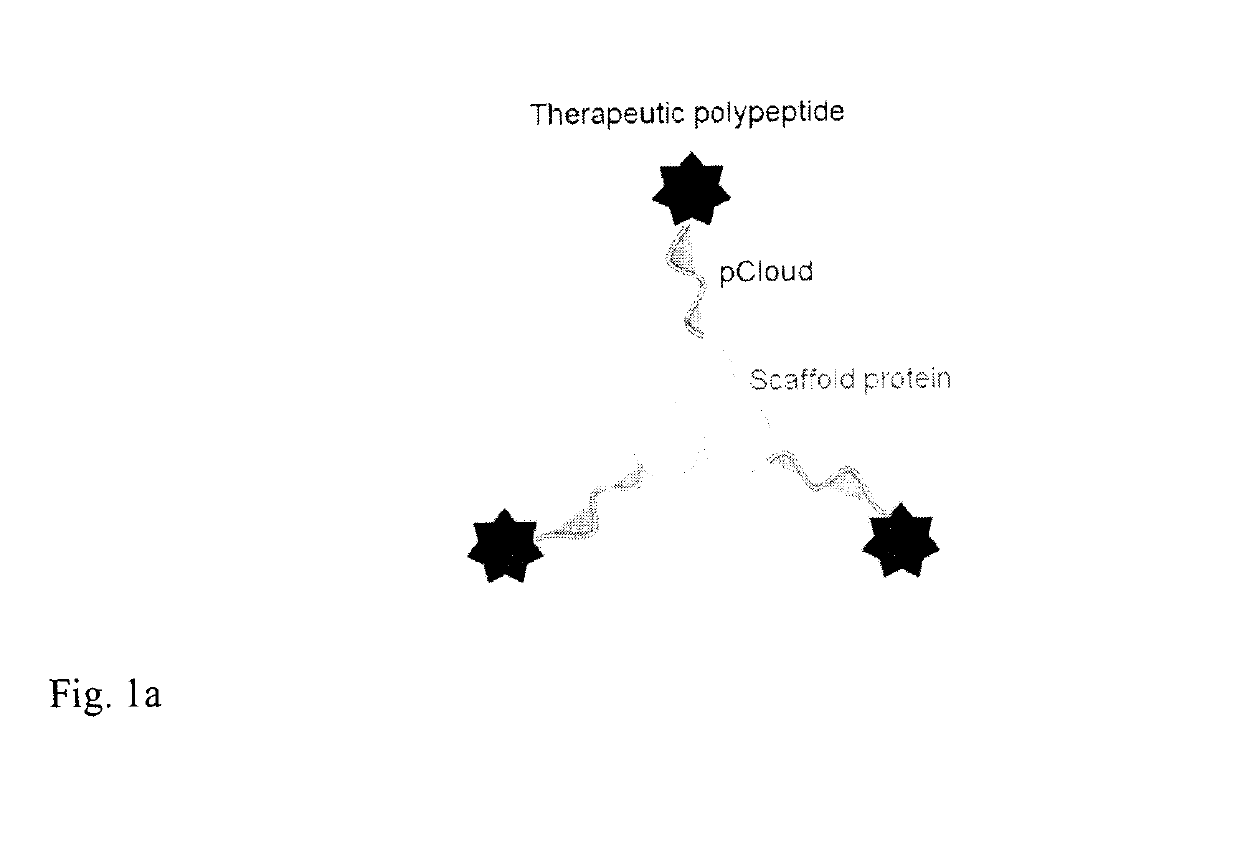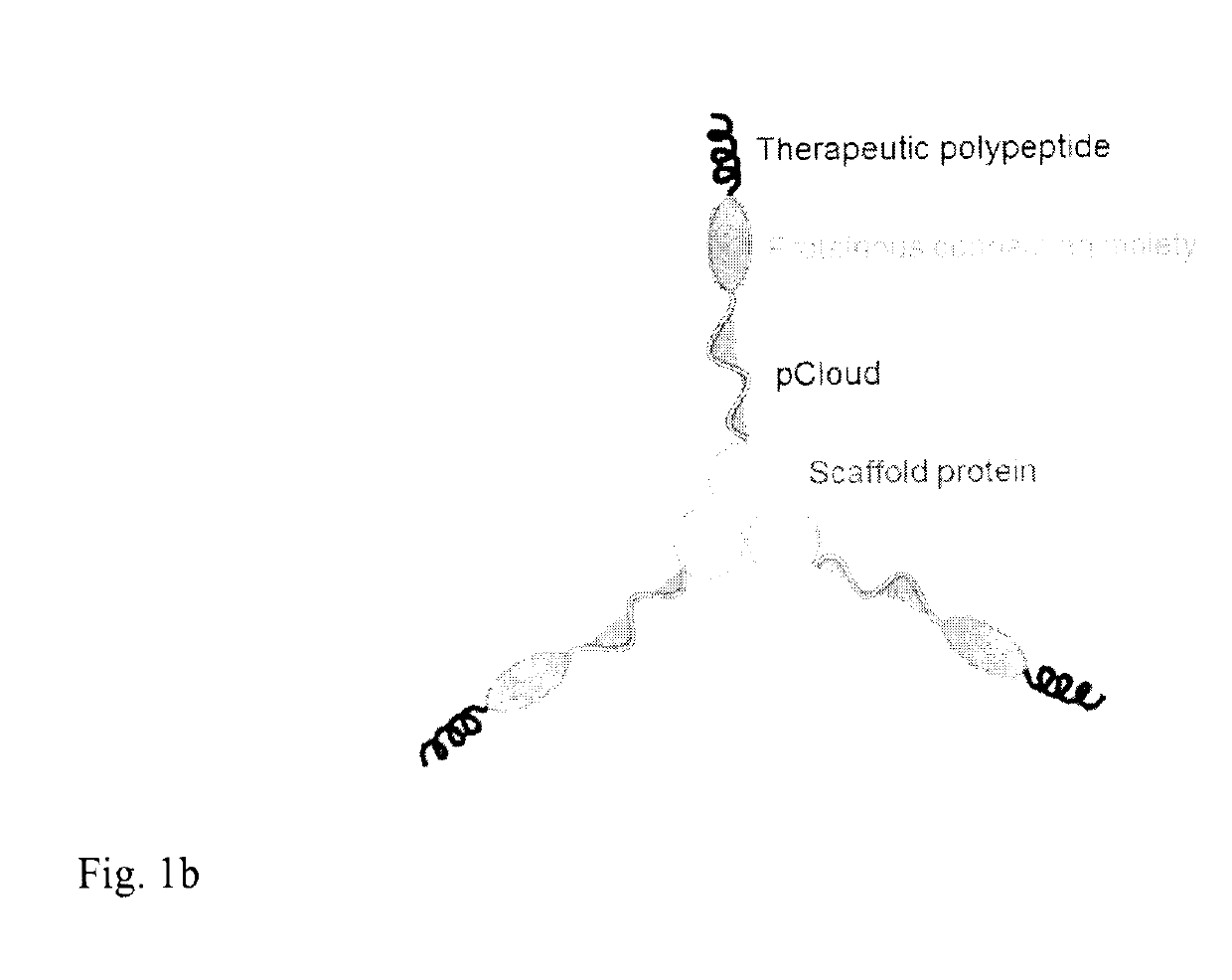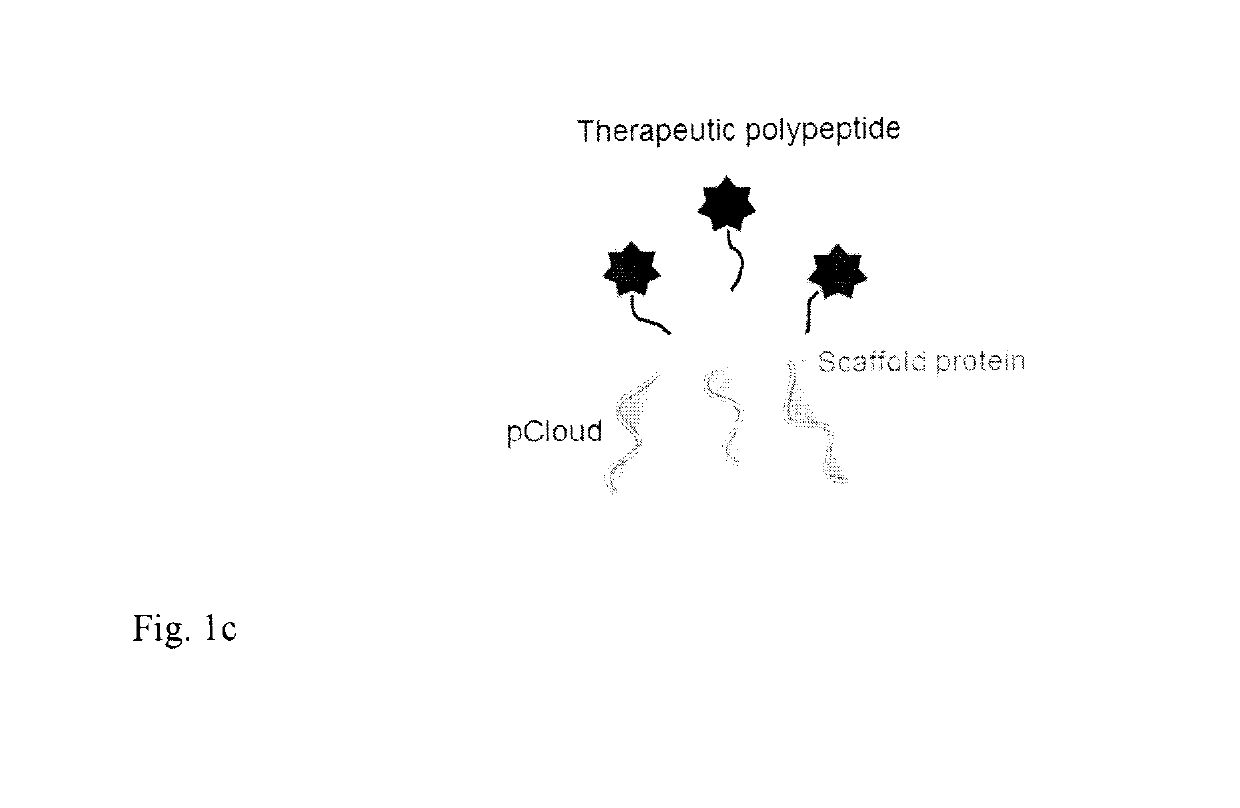Method of improving the pharmacokinetic profile of a therapeutic polypeptide and the use thereof
a technology of a therapeutic polypeptide and a pharmacokinetic profile, which is applied in the direction of peptide/protein ingredients, parathyroid hormones, metabolic disorders, etc., can solve the problems of short terminal in vivo half life of polypeptides, poor thermal stability when injected into subjects, and severe consequences of pegylation on the biological activity of proteins, etc., to improve the pharmacokinetic properties, stability and solubility of the therapeutic polypeptid
- Summary
- Abstract
- Description
- Claims
- Application Information
AI Technical Summary
Benefits of technology
Problems solved by technology
Method used
Image
Examples
example 1
ion of an Expression Vector of GLP-1 Fused with Human Fibronectin Type III Domain 7 (Fn7) and Human Collagen XVIII NC1 Domain (COL18NC1)
[0142]In this example, GLP-1 polypeptide was fused to the N-terminus of the human collagen XVIII NC1 domain (COL18NC1) which forms a stable homo-trimer. To further extend the Rg of the molecule, the human Fibronectin type III domain 7 (Fn7) was utilized as the proteinous connecting moiety. Fn7 was connected to the GLP-1 polypeptide and COL18NC1 through a flexible loop (GGGSGGGG; SEQ ID NO:77) and a flexible, unstructured linker (GGGSGG; SEQ ID NO:89). The pET29b vector (Novagen) was used to construct a recombinant plasmid containing the GLP-1-Fn7-COL18NC1 fusion gene. First, human COL18NC1 was cloned into pET29b by BamHI and XhoI to result in the pET29b-COL18NC1 vector. PCR reaction was carried out using human collagen XVIII cDNA as the template by using the following primers:
[0143]
(SEQ ID NO:78)Col18NC1-forward:CGGGATCCGGTGGCGGCGCCTCCTCAGGGGTGAGG (...
example 2
f GLP-1 Fused with Fibronectin Type III Domain 8 (Fn8) and Human Collagen XVIII NC1 Domain (COL18NC1)
[0149]Other human Fibronectin type III domains may also act as the proteinous connecting moiety between the therapeutic polypeptide and the scaffold protein in our method. In this example, we showed that Fibronectin type III domain 8 (Fn8) can be utilized as the proteinous connecting moiety between GLP-1 and collagen XVIII NC1 domain. The gene encoding GLP-1 and human Fibronectin type III domain 8 (Fn8) was amplified by PCR using the following primers and human Fibronectin cDNA as the template:
[0150]
Fn8-Forward:GGAATTCCATATGCATGCCGAAGGGACTTTTACCAGTGATGTAAGTTCTTATTTGGAAGGTCAAGCTGCAAAAGAATTCATTGCTTGGCTGGTGAAAGGCCGTGGTGGTGGCGGCTCTGGTGGCGGTGGCTCTGCTGTTCCTCCTCCCACTGACCTGCGATTC (SEQ ID NO:82)Fn8-Reverse:CGGGATCCACCACCACCTGTTTTCTGTCTTCCTCTAAGAGGTGTGC(SEQ ID NO:83)
[0151]The PCR product was digested by NdeI and BamHI. The digested insert was ligated into the digested vector pET29b-COL18NC1 (g...
example 3
n and Purification of Fusion Protein GLP-1-Fn8-COL18NC1
[0153]The constructed expression vector pET29b-Glp1-Fn8-COL18NC1, after sequencing confirmation, was used to transform Escherichia coli BL21 (DE3) for protein expression (for detailed protocols of the transformation, see Molecular Colning: A Laboratory Manual). A single colony was selected from the culture dish, and placed into a 10 ml LB liquid medium with kanamycin (final concentration, 50 μg / ml), then shaken at 37° C. at 220 rpm overnight. 1L LB culture was inoculated and allowed to grown until OD600 reached 0.4-1.0. Isopropyl thiogalactoside (IPTG) was added to a final concentration of 0.2 mM. After a successive culture at 30° C. for overnight, cells were collected by centrifugation. The cells were diluted 1:20 with 20_mM Tris, NaCl 50_mM, 2 mM EDTA, pH 8.0, and, after a thorough mix, disrupted by sonication. Insoluble precipitates were removed by centrifugation at 13,000 RCF for 30 min. The proteins of interest were present...
PUM
| Property | Measurement | Unit |
|---|---|---|
| concentration | aaaaa | aaaaa |
| molecular weight | aaaaa | aaaaa |
| molecular weight | aaaaa | aaaaa |
Abstract
Description
Claims
Application Information
 Login to View More
Login to View More - R&D
- Intellectual Property
- Life Sciences
- Materials
- Tech Scout
- Unparalleled Data Quality
- Higher Quality Content
- 60% Fewer Hallucinations
Browse by: Latest US Patents, China's latest patents, Technical Efficacy Thesaurus, Application Domain, Technology Topic, Popular Technical Reports.
© 2025 PatSnap. All rights reserved.Legal|Privacy policy|Modern Slavery Act Transparency Statement|Sitemap|About US| Contact US: help@patsnap.com



